Bulwark: Falconeer Chronicles review: cliffside citybuilding that dries up sooner than you'd hope
Sinking feeling
Maintaining the thrum of a finely-tuned citybuilder has to be one of the most satisfying acts of video game plate-spinning around. Nursing that constant flow of foot traffic, produce and profits, all of them teetering on a carefully honed knife-edge, that's the good stuff right there. Of course, it's not always the threat of imminent and total collapse that fuels these mighty engines of urban planning. Sometimes it's the simple pleasure of building itself, watching a scrub of dirt track rise up into an advanced superhighway of architectural wonder. The best of these more relaxed kinds of citybuilders - your Dorfromantiks and your SteamWorld Builds et al - still involve plenty of plate-spinning; it's just that they won't ever fall over if you take your eye off the ball for a moment.
Bulwark: Falconeer Chronicles sits at the citybuilding crossroads of 'relaxed' and 'something more'. It wants to be an easy-going kind of builder, as nothing fundamentally bad happens when the wheels stop turning for a moment. For the most part, you're free to build where and however you please, constructing imposing fortresses jutting out into the ocean from mere scraps of rock. But it also gets more bogged down in the minutiae of resource flow, worker management and conquest and expansion via muddy, ill-defined combat procedures than it probably should. It always feels on the precipice of becoming something bigger, bolder and more boisterous than it ever really achieves, dipping its toes into the murky waters of its lonely Ursee without truly ever getting its feet wet.
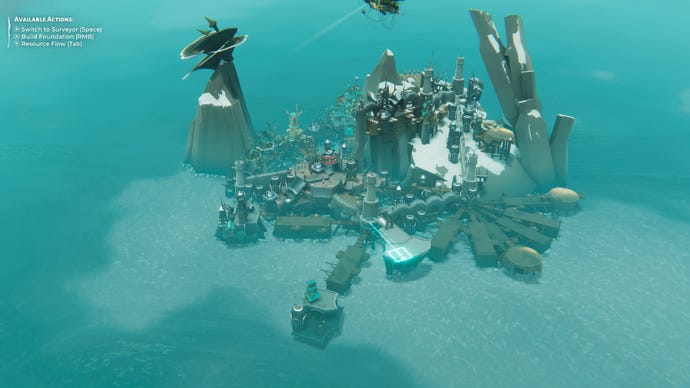
As a solo developer project, Bulwark still feels impressive in its own right - even if it's ultimately one that's subject to a debilitating amount of feature-creep. When you fire it up, you're presented with a sort-of campaign mode that consists of three starting scenarios, and a free build mode where you can really go to town with its seaside construction systems. I say 'sort-of-campaign', as there's no real goal in Bulwark. You can just keep building and building until you've had your fill. Sure, you could probably conquer the oceans if you wished, but there are no objectives or victory conditions per se telling you to do so, or what you should aim for next. You make your own fun in Bulwark, which can feel quite freeing on the one hand, but directionless on the other.
The first scenario has a tutorial of sorts that teaches you the basics of how to build and get your settlement up and running, but most of its later-game queries, such as how combat works, are hidden away in its help menu. Other questions I had, though, are never answered at all, such as 'why can't I build another extractor on this nearby stone quarry?' and 'am I really making the best use of these outposts I seem to keep collecting?' It can often feel like you're clutching at straws as a result, making Bulwark the kind of citybuilder you probably need to try and fail at (or at least muddle along with) two or three times before you really feel like you've got the measure of it - because the game itself isn't going to help you understand it in any great detail. Some folks will no doubt thrive on feeling your way around its borders like this. But the more I played, the more I found myself listing in the other direction, just wanting some straightforward answers for how certain parts of it actually worked.
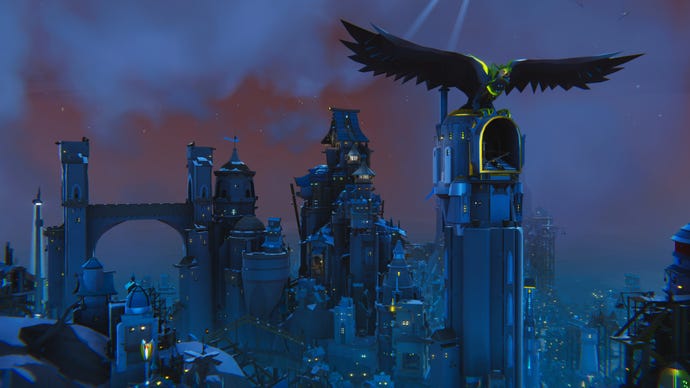
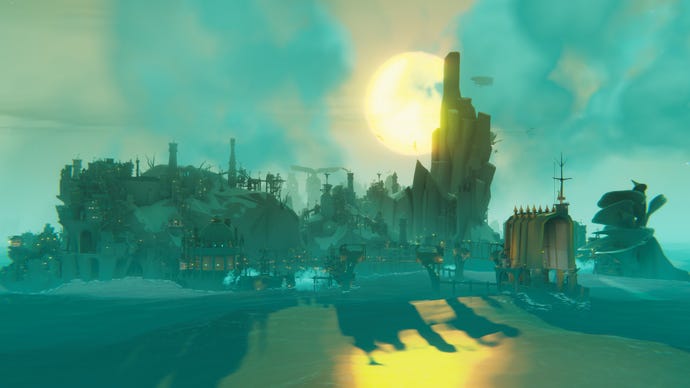

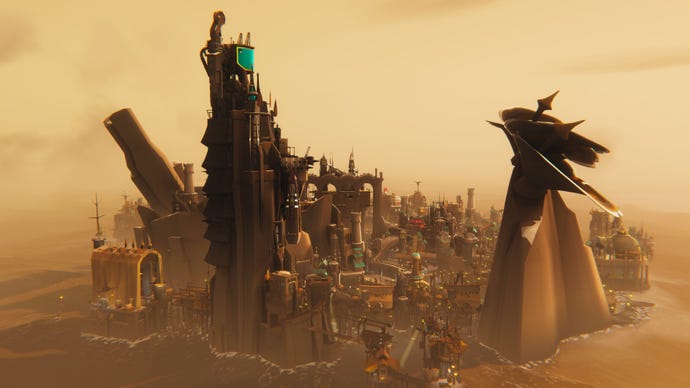
The fundamental act of building, though, is quite satisfying, and watching your settlements edge further and further out into the sea really feels like you're defying the odds as you try and make a life for yourself. The first thing you'll need to do is connect your outpost to a wood mill, as without wood, nothing can be accomplished at all. It's one of three main resources in Bulwark - the others being stone and iron - and once you've got walkways and towers connected to their respective extractor sites, resources will flow freely (for the most part), with houses cropping up automatically along your bridges and jetties.
It's a very easy kind of citybuilding. While resource sites can be depleted, they take a long time to do so, and they're effectively infinite in quantity while they're being mined. There are no real limits on how much you can build in the early parts of the game, and you'll feel little need to hit Tab to toggle on the Resource Flow menu. Remember this menu exists, though, as I'll be returning to this later. Instead, you'll be too busy creating a spiderweb of walkways around your starting location, constructing towers and laying foundations to give you more solid ground to work with as you expand into the deeper and deeper water. Once you have stone and iron, you can also upgrade your buildings further, like ever higher towers that reach upwards into the foggy heavens, and balconies to support even more elaborate skyways. Eventually, you'll also be able to assign captains and commanders to these towers to increase your military might and resource production, each one bringing their own unique trimmings to make them instantly stand out against your settlement's skyline.

However, these feats of engineering magnificence are often spoiled by its finicky camera. It can be hard to select specific buildings or towers with your mouse unless the angle is just so, or you spin it round to view everything from completely top down to erase any question of depth perception. It's a minor nitpick in the grand scheme of things, but it raises its head just often enough to feel like you're always wrestling with it - particularly when you swap over to your airborne surveyor ship, which you'll be piloting round the Ursee in search of other outposts and event-based question marks to build up your settlement further.
Like SteamWorld Build, you can comfortably leave your settlement to hum along in the background while you're out in surveyor mode. I mean, there's nothing you actually need to keep an eye on in Bulwark, as you don't have to worry about resources running out, or keeping citizens happy, or anything, really, so you can pop off in your airship whenever you feel like it. In fact, this was where I ended up spending most of my time once I'd got my basic settlement going, as it's only through exploration that you'll find new faction outposts to hoover up, new trading ships to bring into your fold, and unique buildings to airlift back to your main home.
However, it's this late-stage of Bulwark's scenarios where its foundations start to feel increasingly wobbly. Unique buildings are all well and good, for example, but they have literally no purpose other than looking nice. Similarly for the vessels you'll find that say they'll bring 'new businesses' to your settlement if you agree to take them in. What businesses? What goods? Businesses aren't a concern or even a selectable building type in this game, so what good do these new recruits actually bring? Thankfully, other encounters are more profitable. Trading vessels are handy when your nearest source of iron, say, is three islands over, and fighter ships are great at keeping them safe as they ferry resources back and forth.
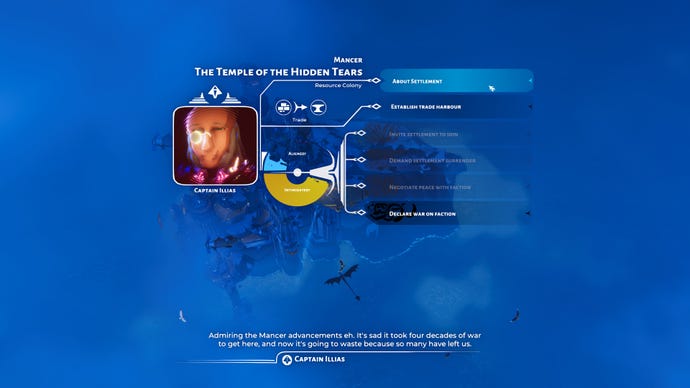

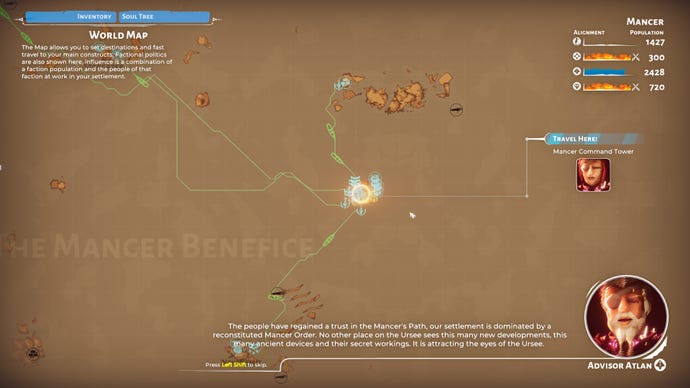
Refugee outposts, on the other hand, can add more people to your settlement - though when their only purpose seems to be to man your towers, they too end up feeling quite superfluous as the game goes on. As actual outposts, however, they feel deeply underutilised. You can theoretically plonk them down anywhere on the map with shallow water, but as I mentioned earlier, you can't build anything in Bulwark without access to wood - and to mine the world's many, many resource spots, you need individual extractor tools for each resource in question. How many extractors does the game give you by default? One of each, for your main settlement. And how do you get more of them? The game doesn't tell you.
As a result, you simply end up assimilating most of these outposts into your wider settlement, adding yet more functionless buildings to your ranks. This was one of my main sticking points in Bulwark, as it was only on my third playthrough, after several hours of bumbling around in the dark that I finally found my answer. I could either take over another settlement by force and dismantle their extractor that way (if they had one), or hope in vain to find a refugee camp event that came with one of its own. The latter only happened once during my review time, and it arguably came far too late for it to feel like a cause for celebration. I can understand not wanting to flood the place with readily available extractor tools, but when the game's solo developer Tomas Sala proclaims in the start up screen tutorial that the game is about "chaotic creativity", and the trick is to always "keep building", it also begs the question: well, why not?
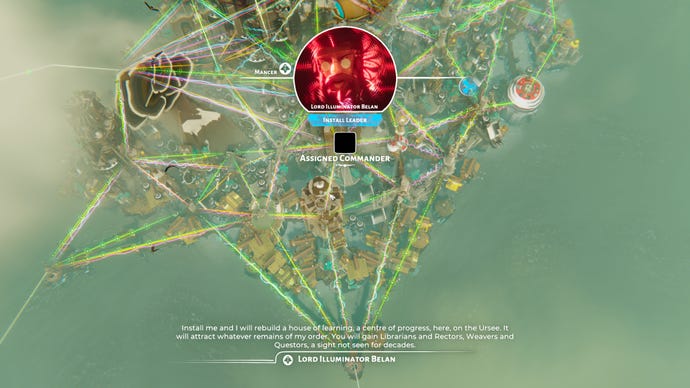
Resources having a set range of travel also feels at odds with Bulwark's promise of easy, unhindered construction. Remember that Resource Flow menu? Toggle this on and you'll be assaulted with a mass of coloured squiggly lines showing how workers and resources move through your growing city. But while the quantity of each resource may be technically infinite, they'll only travel a certain distance from their respective extraction site (or harbour, if it's coming from overseas). This isn't brilliantly explained in the tutorial, and it wasn't until I consulted the help menus that I realised why, despite a healthy supply of iron in my harbour, I couldn't upgrade some of the towers further into my settlement. I had a great network of walkways going, but the towers I wanted to upgrade lay beyond its incredibly limited building range, stopping me from making progress. Once again, this is a somewhat arbitrary limit to place on construction, especially when extractors are so few and far between. It feels like you're being imprisoned rather than encouraged, and while dismantling is free and comes without penalty, it's a right old chore to rearrange everything.
Thing is, though, by the time I started finding more extractors, I wasn't actually making much progress anymore. I was simply killing time, waiting to see if something else would happen. It's like being stuck in a Fallout game that just endlessly feeds you with more of the same stuff to do - more captains to find, more trading boats to bring in, and yet more refugees to deposit somewhere. Really, the only thing that did seem to happen the longer I played was other enemy factions started to bristle with fear across the seas, my giant settlement sending the entire Ursee into a spiralling, never-ending war.
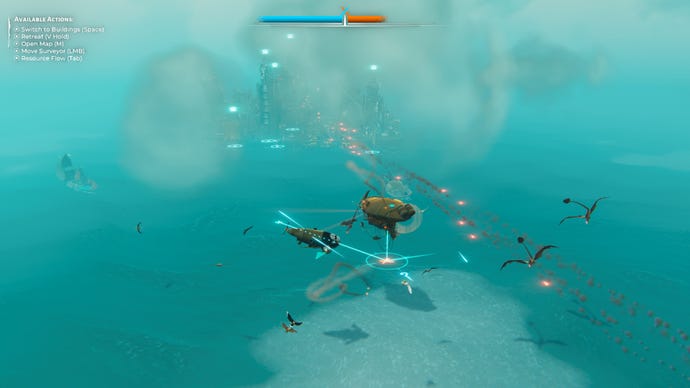
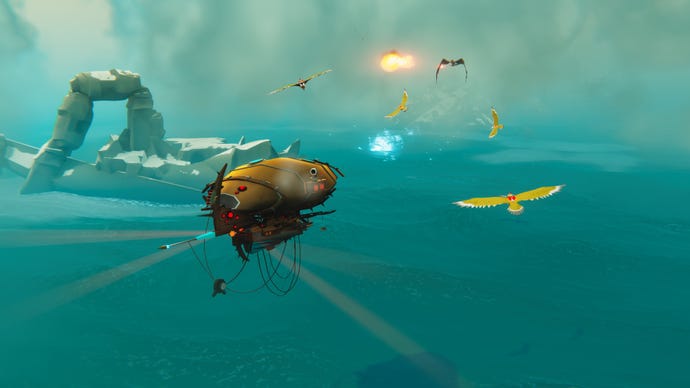
And yes, combat does fill the void somewhat. Enemy settlements will frequently try and disrupt your trade routes, regardless of whether you have fighter ships protecting them or not, but you can also bring the fight to their door and conquer them with your retinue of accompanying fighter falcons. But this, too, grows stale after mincing your fifth large settlement with ease, if only because it's never really clear how fights actually work. There's little to no strategy involved - firing your guns all happens automatically, and I couldn't tell you if clicking my ship around in the sky actually makes any difference versus standing still and letting the cannons rain down from above.
It all just starts to feel like you're endlessly spinning plates without any real end in sight. Each campaign scenario is more of the same, too, offering little more than a change in starting position and faction type. For some, £15/$20 will be a more than adequate price of entry for that. But it also feels like Bulwark is on the cusp of something greater, like it's aiming to be an Anno but never quite getting there in the process. It ultimately spreads itself too thin, doing lots of things well without being brilliant, and lacks the depth and momentum to make it feel satisfying on a strategic level. It's a citybuilder that hums along quietly, but lethargically, sputtering occasionally as you change gears, and eventually petering out altogether as both you and the game become completely and utterly exhausted by it all.
This review is based on a retail build of the game provided by publishers Wired Productions.









